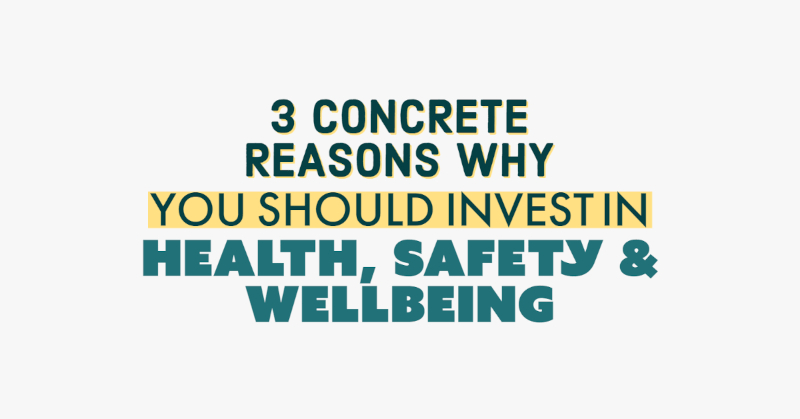Picture this: you’re the esteemed leader of a thriving new business, in an exciting early growth phase. You’re entering new markets, taking on new clients like never before, and hiring recruits to help bulk out the team. The birds are chirping and your LinkedIn following is growing, thanks to a host of articles naming you in their ‘Top 10 Entrepreneurs To Watch This Year”, or for the young and naïve, the "30 Under 30" list.
But somehow, somewhere along the way, things change. You find yourself reading a report about the fifth incident in a string of unfortunate events related to forklifts. Your dwindling number of available drivers are now in short supply, and your orders are pushed back. Everything’s getting behind schedule, and there’s clearly a problem with your operations, which somehow needs to be identified, pronto.
Oh, and Susan from marketing quit out of the blue, citing poor mental health as her reason. A week later, she’s blasted your company with lengthy digital posts; exposing a shocking work culture that puts mental health on the back burner. As per the internet, there now exists (forever) a damning, dire warning on GlassDoor (and LinkedIn!) to anyone thinking about applying for a job.
Also, Jim, your cheerful accounts manager, slipped on an unknown substance in the kitchen and severely fractured his jaw. Unable to talk, he’s out of full-time work for at least four weeks while his face heals. You’re left stranded, with mounting ACC costs and the impending, inevitable levy increase that will hit you at the end of the year.
Need I go on?
Yes.
Yes, I will.
The examples of workplace issues are endless, and the potential consequences of neglected health, safety and wellbeing can extend far beyond a single, isolated incident.
Whether a business is new, established, or even just somewhere in-between, addressing and investing in health and safety isn't necessarily near the top of their priority list. Not only is it difficult for leaders and managers to predict potentially devastating outcomes of workplace health and safety gone wrong, but it also feels like an exhausting amount of pessimistic effort, far better swept under the proverbial rug.
However, as illustrated above, health, safety and wellbeing encompass that vast area of ultimate importance to a business; that is human activity and productivity.
If your business is a vehicle and your workforce the driver, then health, safety and wellbeing is the lubrication that keeps the car from a total breakdown. You would check your oil before a long road trip, right?
Health, safety and wellbeing might be overlooked, but its bond to productivity is a marriage so integral that it should be at the very starting line of any organisational roadmap, or vision (or whatever other buzzword you see apt to name your list of priorities).
Need more convincing?
Get fresh H&S insights weekly
The Investor’s Edge
Traditionally, we’ve all treated health and safety as an internal problem, something for the ever-weary H&S or HR manager to suffer over, bleating about wearing hi-vis gear at the monthly meetings, with no real gravitas.
However, today’s reality looks a little different. Investing in safety, keeping it at the heart of business strategy is a guaranteed way to help meet both your corporate and financial goals, and establish long-term credibility in the eyes of potential investors. In fact, demonstrated health, safety and wellbeing practices show an organisation’s ability to both manage and mitigate high-risk situations while continuing to meet sustainable long-term goals.
In the past decade, researchers have noticed a sharp increase in work-related safety accidents and even fatalities, which has signalled a need for this shift from treating health and safety like a backburner project, to a pivotal foundation of the business itself.
Therefore, ESG (Environment, social and governance) factors are increasingly becoming more relevant for investors. Under the umbrella of health and safety, researchers have found that for every $1 spent on safety, the average return yielded $4.41 back. Researchers in Europe estimate that the final cost of a minor injury was 16 times greater than the cost of implementing an effective preventative measure - that would have avoided the minor injury altogether.
Without a doubt, when it comes to the numbers, investing in health, safety and wellbeing is just good business, plain and simple.
Time and time again, studies have found a link between a strong ESG performance and a company’s bottom line - proving that a big picture focus that extends beyond profit is becoming the new competitive edge, transforming how we conduct business today.
A safe work environment facilitates increased productivity
It’s no secret that better employee productivity drives business growth and greater profits. As a manager, you’re always wanting to get the most out of your people. How do you achieve this, without the expense of weakened mental health or crushed morale?
The first step lies in making sure that your workplace is a physically safe and clean environment. When you invest in a safe environment, you create better working conditions, which help to keep your people safe to avoid costly injuries or illnesses.
The worse the workplace conditions, the more frequently sick days have to be taken. The more workplace hazards causing carnage, the greater the potential for incidents and near-misses.
In Frederick Herzberg’s two-factor theory of motivation, the presence of workplace hazards or unsafe practices are both examples of dissatisfying factors. According to Herzberg, when these are present, they are demotivating for workers. However, when they are dealt with (i.e. the workplace becomes safer) it’s not actually a source of motivation for workers. In short, workers only notice safety issues, when it becomes, well, an issue.
It fits with Maslow’s hierarchy of needs too - another key theory of motivation. Maslow considers motivation as part of a pyramid of needs, which begins with physiological needs at the bottom, moving through to self-actualisation at the top. Workers whose basic needs are not being met in an unsafe workplace are less likely to fulfil higher-level needs, and remain stuck - and potentially lack esteem or purpose. On the flip side, creating a safe working environment that promotes productivity helps your people address their higher needs, with better output.
When workers’ safety needs are fulfilled and their workplace is satisfying, they’ll be motivated and productive. Keeping a working environment safe looks as simple as investing in high-quality office or warehouse equipment, clean and sanitary bathrooms and kitchen areas - all the way to the higher-level areas such as a streamlined system in place that helps record data from historical incidents and reduce safety gaps in the workplace.
Without a doubt, a healthy and safe working environment that supports wellbeing reduces costly issues such as absenteeism, alongside near-misses and injuries.
.jpg?width=1200&height=628&name=My%20Post%20(24).jpg)
Happy employees are safer workers
The flow-on effect from creating a safer working environment and actively demonstrating a keen top-down interest in health, safety and wellbeing is the value of looking after employee mental health.
Aside from the overt mental benefits that come from investing wholeheartedly in effective employee wellbeing programmes, there are simultaneously major financial returns that such an investment yields. Xero noted that every $1 NZ businesses invest in wellbeing programmes yields up to $12 in returns - coming from increased productivity, decreased absenteeism and heightened team morale.
...Every $1 NZ businesses invest in wellbeing programmes yields up to $12 in returns...
There’s a reason the return is quite so high.
When you give people permission to prioritise their mental health, they’ll be a better mental framework to bring their most productive self to the office. The employer-employee relationship will strengthen, and employees can develop a strong loyalty to their workplace. Investing in incentives such as EAP services promote a widespread effort to take mental health seriously, and indirectly communicate that you value your team as people too. Not only does your relationship strengthen, but the quality of work improves too.
Strong relationships go one step further. In the long-term, developing high quality, genuine relationships with employees facilitates high rates of retention, and these relationships are fundamental to an authentic, enjoyable company culture. When managers respect and support their employees’ mental wellbeing, the office becomes a welcome place for people to spend a large portion of their day, which decreases the rate of labour turnover.
Focusing on strengthening mental health in the workplace helps to reduce collective stress. Stress is a dangerous beast and can be the catalyst for poor decision-making, potentially leading to unsafe practices. Likewise, poor mental health affects how alert and careful workers are.
When you’re stressed, it’s harder to think broadly or to follow a set protocol correctly. Stress keeps us in the future, focused and worried about achieving a specific outcome. As a result, it’s easy to cut corners to get there efficiently. This is a dangerous mental space for people to be in, especially when working in highly physical jobs, where mistakes are costly.
Without a doubt, keeping your people happy and keeping your collective stress levels low is a crucial element for any leading workplace.
Final words
Picture this: you’re the esteemed leader of a thriving new business, in an exciting early growth phase. You’re entering new markets, taking on new clients like never before, and hiring recruits to help bulk out the team. The birds are chirping and your LinkedIn following is growing, thanks to a host of articles naming you in their ‘Top 10 Entrepreneurs To Watch This Year”, or for the young and naïve, the "30 Under 30" list.
Your business and all your people are thriving. You’ve achieved record health and safety stats (low) and present an exciting ESG agenda for all stakeholders. Your people are productive, safe and happy, and staff are often commenting on what a great place it is to work at your business.
In fact, your bottom line has never been higher.
Need I go on?
No. I need to write another blog.
It’s time to shift how we perceive health and safety. It’s not a second-thought, back of the queue part of the business, best left for HR or H&S managers only. Rather, health, safety and wellbeing are the new cornerstones of a successful, innovative 21st-century business. Prioritising your investment in health, safety and wellbeing is the proactive approach.
From improving workplace productivity, mental health and customer-employee relations, all the way to creating a stronger ESG position for your stakeholders, health, safety and wellbeing has never been more critical to get right.
It’s time to step up and be the leader in your industry. Pave the way for your people, and your business will thank you for it.
Want to know more about how to create a better health and safety culture? View ecoPortal smarter safety videos. ecoPortal health and safety software can also help your business. Try a demo or get in touch with the team at ecoPortal.




.png?width=352&name=Copy%20of%20RETAIL%20SAFETY%20(2).png)

.jpg?width=352&name=AI%20health%20and%20safety-1%20(1).jpg)


